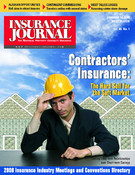While winter storms do not attract the attention of mega-catastrophes such as hurricanes and earthquakes, these smaller events can add up to impact insurers’ bottom lines. However, insurers can now avail themselves of such risks by using new technology to better assess the risks from winter storms and fires, according to risk modeling experts.
“Following the historic hurricane seasons, companies woke up to the need to better manage their aggregate risk,” said David Lalonde, senior vice president at AIR Worldwide. Smaller events such as winter storms contribute to the aggregate loss, he said. He noted that the entire United States is vulnerable to extreme winter weather and the losses it can cause, such as damage from high winds, freezing temperatures, roof collapses and ice dams.
Lalonde, who spoke at the recent annual meeting of the Casualty Actuarial Society (CAS) in Chicago, pointed out, there are distinctions among regions, with the West more prone to hurricane force winds, the South exposed to severe freezing, the Great Lakes to localized and lake effect storms and the Northeast prone to Nor’easters with their near hurricane force winds and heavy snows.
Lalonde said that AIR has developed Numerical Weather Prediction (NWP), a tool that reflects the three dimensional structure of winter storms — wind, precipitation and temperature — and their interactions. “The subperils can combine to produce an extreme event,” LaLonde observed.
NWP models the interaction and feedback between the surface and the air aloft, incorporates all known physics about the atmosphere, and runs at high resolution to pick up locally intense winds, precipitation and temperature.
Alok Jha, senior director, Risk Management Solutions (RMS), noted that fire is the biggest portion of the “all other perils” premium. “Fire is not a catastrophic event nor is it a high frequency event,” Jha said. “It is somewhere in between.”
He observed that the historical underwriting practice for fire insurance and risk management has been based on limited data and subjective analysis, which have been aggravated further by lack of relevant fire exposure data.
Jha said that RMS partnered with insurance companies and fire engineering experts and organizations to incorporate their insights and experience into the development of its Account Fire Model.
He described how the model simulates the physical behavior of a fire as it spreads through a building’s open doors and breached firewalls.
Jha further explained that the sophisticated hazard and suppression analysis in the RMS model is coupled with a fire engineering assessment of the vulnerability of the building, contents and business interruption to the fire hazard.
Was this article valuable?
Here are more articles you may enjoy.


 Wall Street Pushes Back After Activists Escalate Protests
Wall Street Pushes Back After Activists Escalate Protests  Allstate Reports Second Quarter Pretax Catastrophe Losses of $2.1B
Allstate Reports Second Quarter Pretax Catastrophe Losses of $2.1B  Progressive Q2 Net Income Skyrockets Over 320%
Progressive Q2 Net Income Skyrockets Over 320%  Man Admits to Tracking Drivers, Programming Keys, Stealing and Reselling Vehicles
Man Admits to Tracking Drivers, Programming Keys, Stealing and Reselling Vehicles 


